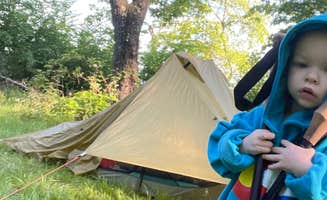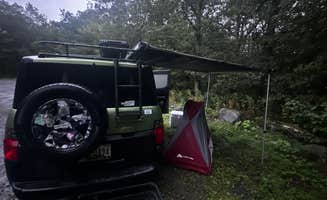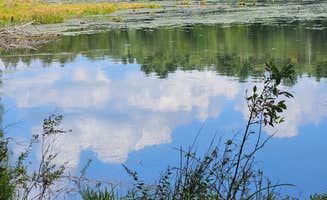Dispersed camping near Mount Bethel, Pennsylvania offers primitive backcountry experiences primarily along sections of the Appalachian Trail and in surrounding state forests. The area sits within the Delaware Water Gap region, with elevations ranging from 400 to 1,600 feet and a humid continental climate featuring four distinct seasons. Winter conditions often limit accessibility to many sites from November through March, with spring bringing significant rainfall and muddy conditions.
What to do
Hike to scenic vistas: The Thunder Swamp Trail system provides extensive hiking opportunities for campers staying at the Thunder Swamp Trailhead. As one visitor noted, "Tons of hiking. Went down Saw Creek trail to a marsh."
Explore lakeside terrain: At Hickok Brook in nearby New York state, campers can enjoy lakeside camping spots approximately 45 minutes from Mount Bethel. One camper explained the layout: "There are only 3 spots where we are. No motor vehicles beyond where I'm camping. Bring everything with you."
Visit mountain overlooks: The Blue Mountain ridge offers hiking opportunities with rewarding views. Bake Oven Knob features a trail described by a visitor as "really lovely; short and rocky." Seasonal trail maintenance varies, with spring and fall typically offering the most well-maintained paths.
What campers like
Overnight parking options: Some trailheads permit vehicle camping for self-contained units. A regular visitor to Bake Oven Knob shared, "I've overnighted in my van here a bunch, no problems. There are two large lots. You can park and sleep, or hike in and find a place for a tent."
Seclusion from crowds: Despite being close to populated areas, many sites remain relatively uncrowded during weekdays. The Thunder Swamp Trailhead provides a "gravel parking lot. Plenty of shade. No one bothered me," according to one camper's experience.
Abundant tree cover: The forest canopy at many sites provides natural shelter and hammocking options. An Appalachian Trail Designated Backpacker Campsite user mentioned, "Good trees for hammocking," noting the site is "well maintained w bear boxes provided."
What you should know
Permit requirements vary: New York state land requires camping permits from the local ranger's office. A Hickok Brook camper learned this firsthand: "Where I originally camped was not a spot, according to Ranger. Had to move next to the lake. Need a permit on NY state land. Contact Rangers office of whatever county."
Water planning essential: Most sites lack reliable water sources, requiring campers to plan accordingly. One visitor at the Appalachian Trail site noted, "I gave the site only four stars because there's no water nearby," adding that campers should "stock up on water at the Dunnfield creek natural area, or wait until Sunfish pond."
Navigation challenges: Many dispersed sites are unmarked and require map reading skills. According to one backpacker, "The site itself is unmarked when you come to it, but it's the only pretty obvious camping spot on the trail so it's not hard to find."
Tips for camping with families
Limited space considerations: Many sites have restricted tent areas which can challenge larger family groups. One camper described an Appalachian Trail site as "a little on the small and sloped side for tent camping," suggesting hammocks as an alternative.
Pack all necessities: No services exist at these primitive sites, requiring complete self-sufficiency. Near Hickok Brook, "It's a hike back to town... there is a small town 10 minutes away. Eldred, NY. Really is a nice quiet place."
Know camping regulations: Different areas have specific rules about where camping is permitted. A hiker reported, "As you enter the Worthington State Forest there are signs and hand painted maps indicating that this is the only place you can sleep in the forest."
Tips from RVers
Access road conditions: Many forest roads leading to dispersed camping areas are unsuitable for recreational vehicles. A truck owner attempting to reach Hickok Brook warned: "The road is very rough with huge potholes so good clearance is a must. It's not a good spot for car camping but you could conceivably drive up to the spots and pull off the road."
Length restrictions: Parking areas at most trailheads accommodate smaller vehicles only. A visitor explained that despite looking for RV options, "I drove in thinking that there would be flat places to park a very rugged camper in my full ton diesel pickup...Very gorgeous but not rv friendly."
Seasonal accessibility: Spring thaw typically renders many forest roads impassable due to mud and erosion, while winter snow often blocks access completely from December through March.




